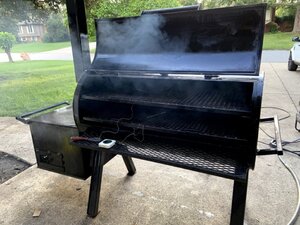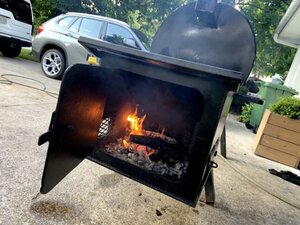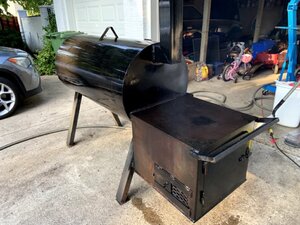daveomak
RIP - Gone but not forgotten.
Original poster
OTBS Member
★ Lifetime Premier ★
Thread starter
Here's to "Alien BBQ" and the folks that first put the calculator together and "1728 Software Systems" for this great "Circle Calculator" and all the folks at "SmokingMeatForums", with a special shout out to Ribwizzard, that contributed their ideas and feedback while this thing was coming together..
The smoker and how it's supposed to work...... click on pics to enlarge.....
Edit: 2-16-2014 ; You will need a hand held calculator, smart telephone, or your computer.... calculator, to use this tutorial.. It does not crunch numbers for you.....
Calculations for a standard design, reverse flow smoker..
Gallons X 231 = volume in cubic inches.... Sometimes the tag, in gallons, reflects a 20% air space for expansion....
Volume of the Cook Chamber.... Use the Inside Diameter of the tank...
Diameter X Diameter X 0.7854 X Length = Volume in cubic inches
Volume in cubic inches X 0.004 = FB/CC opening in square inches
Volume in cubic inches X 0.004 = Area under the RF plate in square inches
Volume in cubic inches X 0.004 = Area required at the end of the RF plate in square inches
Volume in cubic inches X 0.33 = minimum volume of the Fire Box
The above areas are necessary for great air/heat/smoke flow.... using less may cause an overheated FB.... Narrow / Long CC may require an increase in those numbers due to increased surface area friction to volume... Wide/Fat Short CC may use smaller numbers due to reduced surface area friction to volume...
Volume in cubic inches X 0.001 = FB air inlets in square inches...
Recommended 20% upper and 80% lower air inlets... Upper air inlet directly across from the FB/CC opening to facilitate moving heat from the FB to the CC, and insuring good air flow through the CC.. The lower air inlet should be situated at or below the fuel grate.... The two air inlets can share the designated square inches of opening....
Volume in cubic inches X 0.022 = Exhaust Stack Volume in cubic inches, above the CC.... (ESV)
(The increase in volume ~30% shows a dramatic improvement in equalized temperatures across the cooking surface... edit 6/19/15 )
Exhaust Calculation..
ESV in cubic inches_________ ... = Stack Length in inches (36" +/-)
0.7854 X Stack Diameter X Stack Diameter
ESV in c.i. = D2 ... Diameter of the stack squared...
0.7854 x 36
10/3/2019 edit
Adjust the diameter of the stack, until the proper length is achieved... be sure to measure the actual internal diameter of the pipe used..
this is for round stacks only..
This circle calculator is really cool... It does it all.... Just fill in the necessary blanks...
......click on this link......
http://www.1728.org/circsect.htm
For calculating the FB/CC opening.... You are calculating for the GREEN area... that will be the cut-out area in the FB that mates to the CC....
The green area is a segment. It is called a "Segment Area"... That area is the same as the FB/CC opening....
When you open the "Circle Calculator" link, Click on the "bullet" to the left of Radius & Segment Height ED....
Circle Calculator
Click on the 2 variables you know
......Radius and Central Angle...........................Radius & Chord AB
[X] Radius & Segment Height ED.....................Radius & Apothem OE
......................................................Radius & Arc AB
......Chord AB & Segment Height ED................Chord AB & Apothem OE
......Segment Height ED & Apothem OE...........Chord AB & Arc AB
You should have opened the circle calculator and a bunch of boxes will appear below..
and a box called [CALCULATE]..
Enter the radius in the box so marked.... If you tank is 24" OD, and has a 3/8" thick steel wall, the ID of the tank 23.25".... the radius is 11.625"..... these numbers need to be accurate if you want stuff to fit... ALSO, take into account the thickness of the FB steel when cutting out the tank...
When calculating for, and with a FB that is smaller radius, use the FB radius for the football opening...
Enter a guess for the Segment Height ED... I'd start with 6.0
Click on [CALCULATE]....
The other boxes will fill with numbers....
The [Segment Area] box is what you area going to compare with the FB/CC opening in square inches...
If the FB/CC opening number is smaller, change the number in the Segment Height ED box to 5.... continue changing that number until the [Segment Area] matches the FB/CC number.....
Now look at the colored circles above.... Segment height ED is how tall the green area is and corresponds to the area to be cut out.....
Also, [Chord AB] corresponds to the width of the RF plate... NOTE... for ease in fitment, the FB should be at least as wide as the RF plate..
Smoker Calculator reasoning
The concept for the changes is below.... Alien and his associates, did an amazing job putting the original calculator together... 100% of my numbers are based on his original numbers... small changes were made for the improvements due to design changes in smokers.....
The original measurements were taken from SFB smokers with tuning plates I do believe.... The advent of the RF smoker did not make any changes to the calculator... Now the exhaust has to travel twice as far as before, and the original FB/CC opening restricted the air flow from the FB, causing the FB to over heat... Some would get up to 450 deg and higher while the CC wouldn't get over 250.... And then there is the increased friction from the steel.... When using natural draft, any restriction/friction is very detrimental to the flow....
So, on a whim, the FB/CC opening was enlarged, the area under the RF plate was increased and the area at the end of the RF plate was increased... all by 50%.... That solved ALL the problems.... fuel consumption was reduced.... folks were happy....
I personally experienced members improvements and fuel usage by the letters/PMs they wrote me on their improvements...... One additional modification was suggested.... members here, tested a second air inlet to the FB.... directly across from the FB/CC opening... That was a significant improvement of some/most smokers.... If the FB was too hot, it could be cooled by opening the upper air inlet.... Also, the fire had a separate air inlet to adjust it's heat output.... It should be installed at or below the wood fire grate....
All of this has been tested and proven by members building smoker on this forum.... The only place you will find using these numbers... or it used to be... I'm sure many builders are now using these ideas for their builds.... this process has been going for at least 2 years....
Thanks for all your help...... DaveOmak
================== edit 12/24/14
If you are planning a round FB and round CC.... Follow this.....
Volume in cubic inches X 0.004 = FB/CC opening in square inches.... the answer is divided by 2.... then that number is solved for in the circle calculator by manipulating the segment height.. when the radius and segment height box is checked... That will give you the lower and upper halves of the football opening... then double the new segment height number and run the calculator... (if originally it was 4", put in 8").... that's the width of the football, AND the new height of the RF plate... and if you look at the chord AB number, when the 8" segment height was crunched, that is the width of the RF plate....
[/ QUOTE]
good day people. i start writing text through a translator. Maybe someone can count how many inches it takes to cut holes to connect CC and FB? My CC and FB are 20 inches.
Thank you.You are a very good person. you helped a lot. Another question I have these calculations differ between is a ofset smoker or rewers flow smoker?20*20*0.7854*42=13,195 cubic inches
FB/CC & Below and the end of the RF plate
13195x0.004= 53 square inches
13,195x 0.001= 13 square inches air inlets of the FB...
13x .8 = 10 square inches lower air inlet of the FB
13x .2 = 3 square inches upper air inlet of the FB
13195x 0.022 = 290 cubic inches volume of the exhaust stack..
13195 / .7854 x 4 x 4 = 23 inches above the CC exhaust stack...
Now, more is always better in a natural draft system... So, a 4" exhaust stack 35" above the CC will be fine...
53 square inches is the number we will be calculating for using the circle calculator...
Since bigger is better in your smoker, with a 10" radius and a 5" segment height ED, gives us a segment area of 61 square inches.. Slightly bigger than the 53" we calculated above... All is good here...
Now we divide that by 2... and look for the ED that will give us approx. 31 square inches..
View attachment 495411
Perfect... An ED of 3" gives us ~30 square inches... That is 1/2 of the football shape we are calculating for..
Now if we flip that shape over and get a complete football, our opening will be 60 square inches... A big bigger than the original 53 but it will work great... Remember, bigger is better...
View attachment 495415
Did I forget anything ???
I hope this stuff makes sense...
Dave
...
and how is the collector size calculated?The numbers will work for either type smoker....
and how is the collector size calculated?



FB/CC opening...And.... Area at the end of the RF plate opening....And .. undersized exhaust stack......... is restricting the air movement to the CC and allowing the FB to overheat causing fuel wastage...
Not having an upper air inlet .... You lose control of the fire...and... control of the air flow through the CC.....
The 90 deg. restricts air flow through the exhaust.
Hey Dave,For not having upper air inlets.... on the last cook I kept the door cracked open.... Would this achieve the same thing? Or should I figure out how to add the upper inlets?
Opening the door does not reduce air to the fire...
Lastly, for the exhaust. This will be the most expensive and hardest change. Do you think it is worth the effort vs. the amount of fuel I'd be saving?
I would add a 5" exhaust with an oversize plenum, between the food grate and top of the CC...
For the end of the RF plate, 1" is the 25% increase you are looking for... I would make it 2".. and leave the plate where it is... 132% is fine.... That 2" can easily done with an angle grinder and cut-off wheel...

